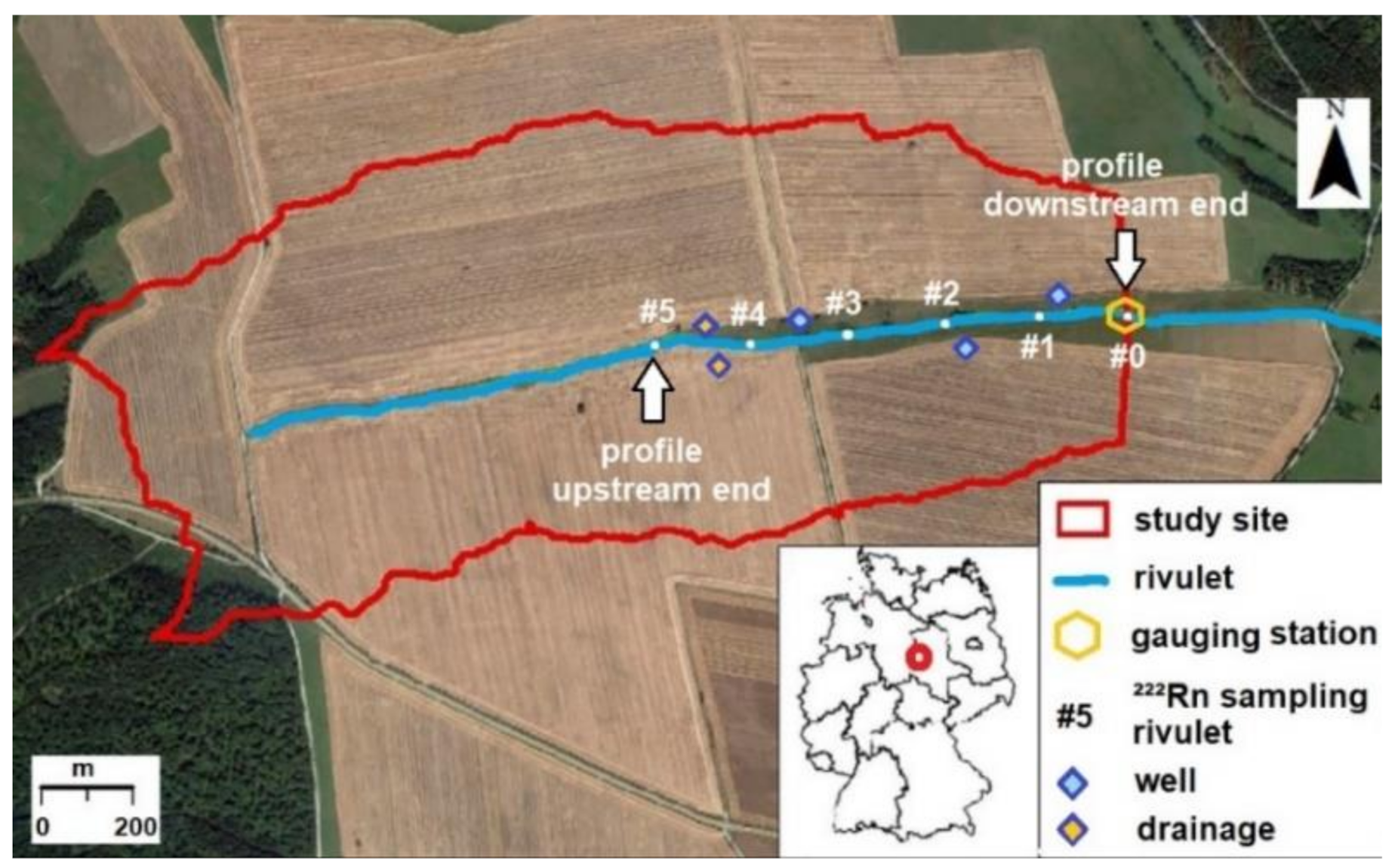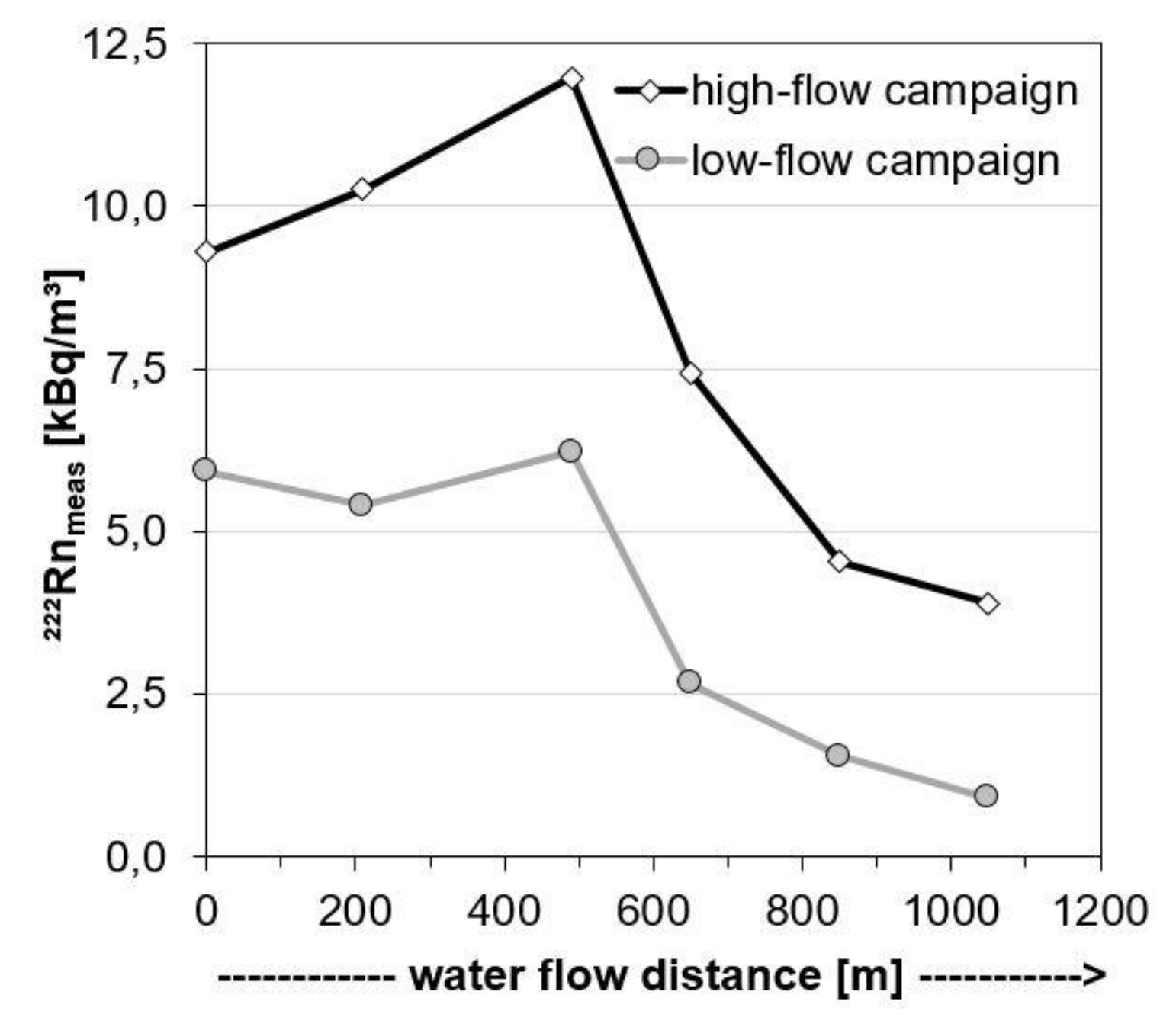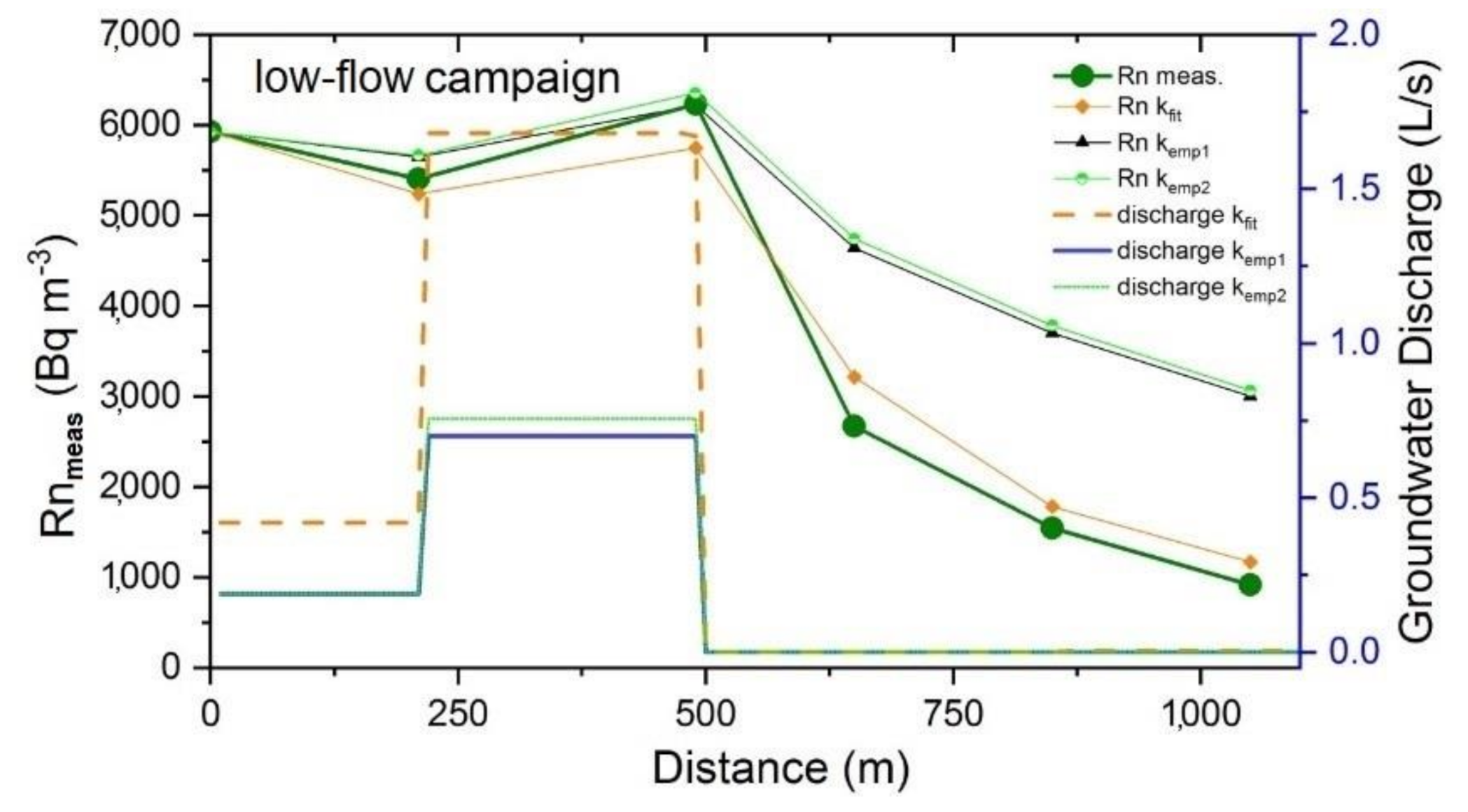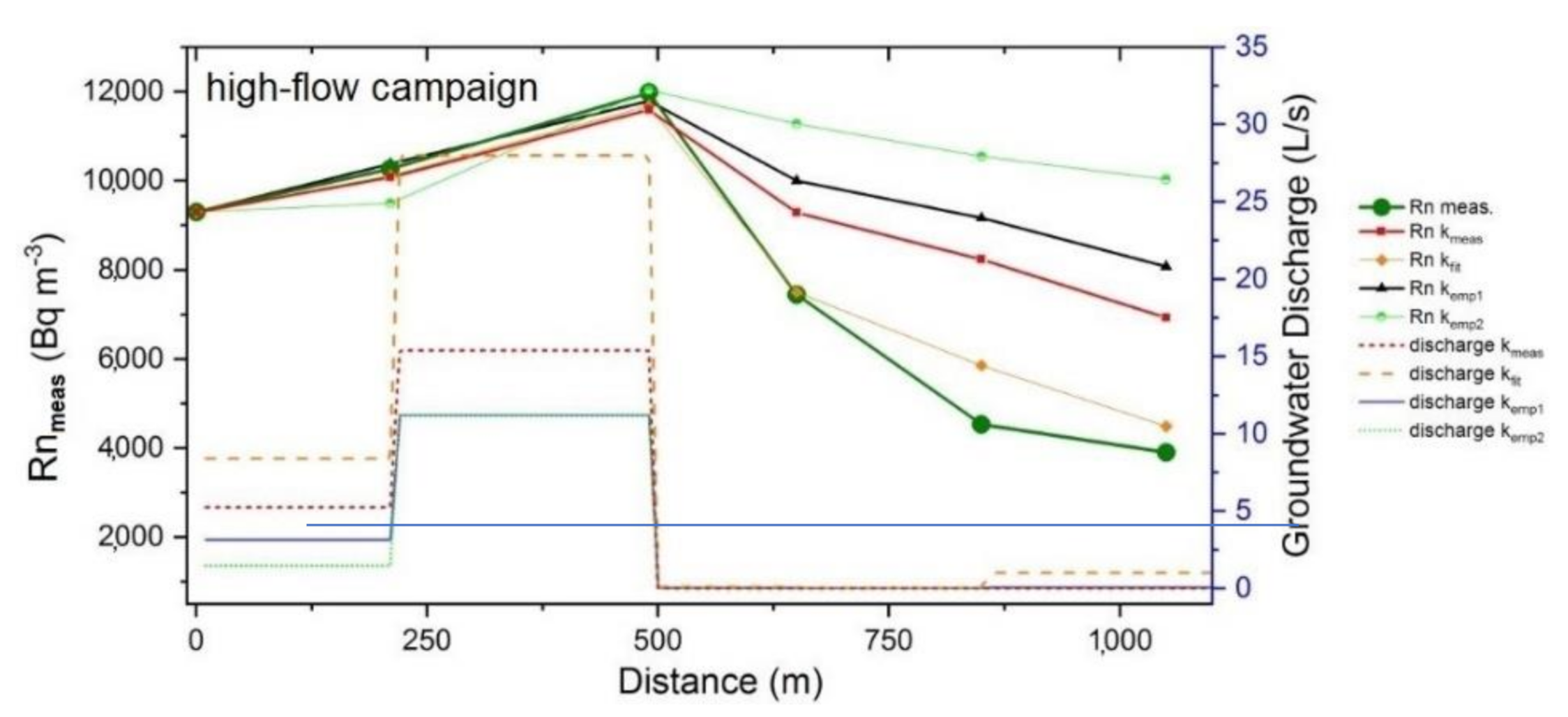Investigating River Water/Groundwater Interaction along a Rivulet Section by 222Rn Mass Balancing
Abstract
1. Introduction
2. Materials and Methods
2.1. Study Area
2.2. Onsite Methods
2.2.1. Radon as Aqueous Tracer
2.2.2. Determination of the Radon Degassing Rate
2.2.3. Determination of 226Ra in River Sediments
2.2.4. Radon Determination in Groundwater and Surface Water
2.2.5. Rivulet Discharge Determination
2.3. Processing of the Field Data with FINIFLUX
3. Results
3.1. Radon Degassing Rate
3.2. Radon Production in the Sediment by 226Ra Decay
3.3. Radon Concentration in Groundwater and Rivulet Water
3.4. Groundwater Discharge Localization and Quantification Using FINIFLUX
4. Discussion
4.1. Site-Specific Results
4.2. General Results
- (i)
- The dimensions of the stream sub-section in question (and of its potential tributaries)
- (ii)
- The water discharge rate of the stream within this sub-section (and of the potential tributaries)
- (iii)
- The sub-section specific 222Rn concentration in the stream water (and in potential tributaries)
- (iv)
- The radon groundwater endmember representative for the hydraulically connected aquifer
- (v)
- The sub-section specific radon degassing coefficient
5. Conclusions
- (i)
- Specifically: The groundwater discharge areas along the investigated section of the rivulet that were suggested by earlier hydrological modeling of the site [12] could be confirmed using radon measurements and mass-balance calculations with FINIFLUX. Groundwater discharge zones could be localized and discharge fluxes quantified, despite significant uncertainty in parameterizing radon degassing in the FINIFLUX model.
- (ii)
- Generally: In contrast to conventional hydrological modeling, the FINIFLUX approach is based on a combination of real tracer data (radon, Br− and propane) and mass-balance modeling. This adds certainty that the distributed highly parameterized process-based modeling is representing the field site realistically. However, in the case of groundwater discharge localization and quantification in small headwater streams, the model is only suitable when the required parameters can be well constrained. While most required input parameters are attainable with reasonable statistical certainty, the determination of reliable values for the following is challenging, but at the same time critical for reliable estimates of groundwater fluxes: (i) the radon groundwater endmember; and (ii) the radon degassing coefficient. In particular, estimation of the radon degassing rate requires a site-specific critical assessment of the reasonability of the used datasets and the resulting outcomes. The determination of both radon groundwater endmember and radon degassing coefficient should hence not rely on only vague estimations or single data sources but be based on as many as possible data sources.
Supplementary Materials
Author Contributions
Funding
Conflicts of Interest
References
- Fleckenstein, J.H.; Krause, S.; Hannah, D.M.; Boanom, F. Groundwater-surface water interactions: New methods and models to improve understanding of processes and dynamics. Adv. Water Resour. 2010, 33, 1291–1295. [Google Scholar] [CrossRef]
- Schubert, M.; Knöller, K.; Treutler, H.C.; Weiß, H.; Dehnert, J. On the Use of Naturally Occurring Radon-222 as Tracer for the Estimation of the Infiltration of Surface Waters into Aquifers. In Radioactivity in the Environment Vol. 8—Radioactivity in the Environment; Povinec, P., Sanchez-Cabeza, J.A., Eds.; Elsevier Book Series: Amsterdam, The Netherlands, 2006; pp. 326–334. [Google Scholar]
- Hutchinson, P.A.; Webster, I.T. Solute Uptake in Aquatic Sediments due to Current-Obstacle Interactions. J. Environ. Eng. 1998, 124, 419–426. [Google Scholar] [CrossRef]
- Sophocleous, M. Interactions between groundwater and surface water: The state of the science. Hydrogeol. J. 2002, 10, 52–67. [Google Scholar] [CrossRef]
- Kalbus, E.; Reinstorf, F.; Schirmer, M. Measuring methods for groundwater / surface water interactions: A review. Hydrol. Earth Syst. Sci. Discuss. Eur. Geosci. Union 2006, 10, 873–887. [Google Scholar] [CrossRef]
- Bishop, K.; Buffam, I.; Erlandsson, M.; Fölster, J.; Laudon, H.; Seibert, J.; Temnerud, J. Aqua Incognita: The unknown headwaters. Hydrol. Process. 2008, 22, 1239–1242. [Google Scholar] [CrossRef]
- Cartwright, I.; Gilfedder, B.S. Mapping and quantifying groundwater inflows to Deep Creek (Maribyrnong catchment, SE Australia) using 222Rn, implications for protecting groundwater-dependant ecosystems. Appl. Geochem. 2015, 52, 118–129. [Google Scholar] [CrossRef]
- Cook, P.G.; Lamontagne, S.; Berhane, D.; Clark, J.F. Quantifying groundwater discharge to Cockburn River, southeastern Australia using dissolved gas tracers 222Rn and SF6. Water Resour. Res. 2006, 42. [Google Scholar] [CrossRef]
- Unland, N.P. Investigating the spatio-temporal variability in groundwater and surface water interactions: A multi-technique approach. Hydrol. Earth Syst. Sci. 2013, 17, 3437–3453. [Google Scholar] [CrossRef]
- Frei, S.; Gilfedder, B.S. Technical Note: FINIFLUX an implicit Finite Element model for quantification of groundwater fluxes and hyporheic exchange in streams and rivers using Radon. Water Resour. Res. 2015, 51, 6776–6786. [Google Scholar] [CrossRef]
- Wollschlschläger, U.; Attinger, S.; Borchardt, D.; Brauns, M.; Cuntz, M.; Dietrich, P. The Bode hydrological observatory: A platform for integrated, interdisciplinary hydro-ecological research within the Tereno Harz/central German lowland observatory. Environ. Earth Sci. 2016, 76, 29. [Google Scholar] [CrossRef]
- Yang, J.; Heidbüchel, I.; Musolff, A.; Reinstorf, F.; Fleckenstein, J.H. Exploring the dynamics of transit times and subsurface mixing in a small agricultural catchment. Water Resour. Res. 2018, 54, 2317–2335. [Google Scholar] [CrossRef]
- Anis, M.R.; Rode, M. Effect of climate change on overland flow generation: A case study in central Germany. Hydrol. Process. 2015, 29, 2478–2490. [Google Scholar] [CrossRef]
- Schubert, M.; Petermann, E.; Stollberg, R.; Gebel, M.; Scholten, J.; Knöller, K.; Lorz, C.; Glück, F.; Riemann, K.; Weiß, H. Improved approach for the investigation of submarine groundwater discharge by means of radon mapping and radon mass balancing. Water 2019, 11, 749. [Google Scholar] [CrossRef]
- Genereux, D.P.; Hemond, H.F. Determination of gas exchange rate constants for a small stream on walker branch watershed Tennessee. Water Resour. Res. 1992, 9, 2365–2374. [Google Scholar] [CrossRef]
- MacIntyre, S.; Wanninkhof, R.; Chanton, J.P.; Matson, P.A.; Harriss, R.C. Trace gas exchange across the air-water interface in freshwaters and coastal marine environments. In Biogenic Trace Gases: Measuring Emissions from Soil and Water; Lawton, J.H., Likens, G.E., Eds.; Blackwell Science: New York, NY, USA, 1995; pp. 52–97. [Google Scholar]
- Roberts, B.J.; Mulholland, P.J. In-stream biotic control on nutrient biogeochemistry in a forested stream, West Fork of Walker Branch. J. Geophys. Res. 2007, 112, G04002. [Google Scholar] [CrossRef]
- Jähne, B.; Haußecker, H. Air water gas exchange. Annu. Rev. Fluid Mech. 1998, 30, 443–468. [Google Scholar] [CrossRef]
- Schubert, M.; Paschke, A.; Lieberman, E.; Burnett, W.C. Air-Water Partitioning of 222Rn and its Dependence on Water Salinity. Environ. Sci. Technol. 2012, 46, 3905–3911. [Google Scholar] [CrossRef]
- Parker, G.W.; Gay, F.B. A procedure for estimating reaeration coefficients for Massachusetts streams. In Water-Resources Investigations Report; U.S. Geological Survey: Reston, VA, USA, 1987. [Google Scholar]
- Genereux, D.P.; Hemond, H.F. Naturally Occurring Radon-222 as a Tracer for Streamflow Generation: Steady State Methodology and Field Example. Water Resour. Res. 1990, 26, 3065–3075. [Google Scholar]
- Cartwright, I.; Hofmann, H.; Sirianos, M.A.; Weaver, T.R.; Simmons, C.T. Geochemical and 222Rn constraints on baseflow to the Murray River, Australia, and timescales for the decay of low-salinity groundwater lenses. J. Hydrol. 2011, 405, 333–343. [Google Scholar] [CrossRef]
- O’Connor, D.J.; Dobbins, W.E. Mechanisms of reaeration in natural streams. Trans. Am. Soc. Civ. Eng. 1958, 123, 641–666. [Google Scholar]
- Negulescu, M.; Rojanski, V. Recent research to determine reaeration coefficients. Water Res. 1969, 3, 189–202. [Google Scholar] [CrossRef]
- Mullinger, N.J.; Binley, A.M.; Pates, J.M.; Crook, N.P. Radon in Chalk streams: Spatial and temporal variation of groundwater sources in the Pang and Lambourn catchments, UK. J. Hydrol. 2007, 339, 172–182. [Google Scholar] [CrossRef]
- Kilpatrick, F.A.; Rathbun, R.E.; Yotsukura, N.; Parker, G.W.; Delong, L.L. Determination of Stream Reaeration Coefficients by Use of Tracers—Techniques of Water-Resources Investigations of the United States Geological Survey; US Department of the Interior: Denver, CO, USA, 1989. [Google Scholar]
- Jin, H.S.; White, D.S.; Ramsey, J.B.; Kipphut, G.W. Mixed tracer injection method to measure reaeration coefficients in small streams. Water Air Soil Pollut. 2012, 223, 5297–5306. [Google Scholar] [CrossRef]
- Oviedo-Vargas, D.; Genereux, D.P.; Dierick, D.; Oberbauer, S.F. The effect of regional groundwater on carbon dioxide and methane emissions from a lowland rainforest stream in Costa Rica. J. Geophys. Res. Biogeosci. 2015, 120, 2579–2595. [Google Scholar] [CrossRef]
- Pittroff, M.; Frei, S.; Gilfedder, B.S. Quantifying nitrate and oxygen reduction rates in the hyporheic zone using 222Rn to upscale biogeochemical turnover in rivers. Water Resour. Res. 2017, 53, 563–579. [Google Scholar] [CrossRef]
- Frei, S.; Durejka, S.; Le Lay, H.; Thomas, Z.; Gilfedder, B.S. Quantification of Hyporheic Nitrate Removal at the Reach Scale: Exposure Times Versus Residence Times. Water Resour. Res. 2019, 55, 9808–9825. [Google Scholar] [CrossRef]
- Doherty, J.E. Methodologies and Software for PEST-Based Model Predictive Uncertainty Analysis. Watermark Numer. Comput. 2010, 2010, 1–33. [Google Scholar]
- Nazaroff, W.; Nero, A.V., Jr. (Eds.) Radon and Its Decay Products in Indoor Air; Wiley & Sons: New York, NY, USA, 1988. [Google Scholar]
- Cartwright, I.; Hofmann, H. Using radon to understand parafluvial flows and the changing locations of groundwater inflows in the Avon River, southeast Australia. Hydrol. Earth Syst. Sci. 2016, 20, 3581–3600. [Google Scholar] [CrossRef]
- Cartwright, I.; Hofmann, H.; Gilfedder, B.S.; Smyth, B. Understanding parafluvial exchange and degassing to better quantify groundwater inflows using 222Rn: The King River, southeast Australia. Chem. Geol. 2014, 380, 48–60. [Google Scholar] [CrossRef]
- Buffington, J.M.; Tonina, D. Hyporheic Exchange in Mountain Rivers II: Effects of Channel Morphology on Mechanics, Scales, and Rates of Exchange. Geogr. Compass 2009, 3, 1038–1062. [Google Scholar] [CrossRef]
- Zarnetske, J.P.; Gooseff, M.N.; Bowden, W.B.; Greenwald, M.J.; Brosten, T.R.; Bradford, J.H.; McNamara, J.P. Influence of morphology and permafrost dynamics on hyporheic exchange in arctic headwater streams under warming climate conditions. Geophys. Res. Lett. 2008, 35, L02501. [Google Scholar]
- Liao, Z.; Lemke, D.; Osenbrück, K.; Cirpka, O.A. Modeling and inverting reactive stream tracers undergoing two-site sorption and decay in the hyporheic zone. Water Resour. Res. 2013, 49, 3406–3422. [Google Scholar] [CrossRef]
- Atkinson, A.P.; Cartwright, I.; Gilfedder, B.S.; Hofmann, H.; Unland, N.P.; Cendón, D.I.; Chisari, R. A multi-tracer approach to quantifying groundwater inflows to an upland river; assessing the influence of variable groundwater chemistry. Hydrol. Process. 2013, 29, 1–12. [Google Scholar] [CrossRef]
- Schubert, M.; Siebert, C.; Knoeller, K.; Roediger, T.; Schmidt, A.; Gilfedder, B. Investigating Groundwater Discharge into a Major River under Low Flow Conditions Based on a Radon Mass Balance Supported by Tritium Data. Water 2020, 12, 2838. [Google Scholar] [CrossRef]
- Baranya, S.; Józsa, J.; Török, G.T.; Rüther, N. A comprehensive field analysis of a river confluence. River Flow 2012, 1, 565–571. [Google Scholar]
- Cook, P.G.; Rodellas, V.; Stieglitz, T.C. Quantifying Surface Water, Porewater, and Groundwater Interactions Using Tracers: Tracer Fluxes, Water Fluxes, and End-member Concentrations. Water Resour. Res. 2018, 54, 2452–2465. [Google Scholar] [CrossRef]
- Petermann, E.; Knoeller, K.; Rocha, C.; Scholten, J.; Stollberg, R.; Weiß, H.; Schubert, M. Coupling end-member mixing analysis and isotope mass balancing (222-Rn) for differentiation of fresh and re-circulated submarine groundwater discharge (SGD) into Knysna estuary, South Africa. J. Geophys. Res. Ocean. 2018, 123, 1–19. [Google Scholar] [CrossRef]
- Delsman, J.; Oude Essink, G.; Beven, K.; Stuyfzand, P. Uncertainty estimation of end-member mixing using generalized likelihood uncertainty estimation (GLUE), applied in a lowland catchment. Water Resour. Res. 2013, 49, 4792–4806. [Google Scholar] [CrossRef]





| Evaluation Method | kRn Low-Flow Campaign [d−1] | kRn High-Flow Campaign [d−1] |
|---|---|---|
| Radon fitting (kRn-fit) | 27.0 | 33.0 |
| Empirical Equation (1) (kRn-emp1) | 10.4 | 7.9 |
| Empirical Equation (2) (kRn-emp2) | 5.5 | 5.9 |
| Propane experiment (kRn-meas) | not executed | 15.9 |
| 22 January 2019 | 13 February 2019 | |
|---|---|---|
| Drainage mean | 23,210 ± 1138 | |
| GW mean | 23,243 ± 1696 | |
| Point #5 | 5924 ± 129 | 9300 ± 657 |
| Point #4 | 5403 ± 052 | 10,265 ± 695 |
| Point #3 | 6227 ± 193 | 11,983 ± 732 |
| Point #2 | 2671 ± 160 | 7447 ± 509 |
| Point #1 | 1543 ± 062 | 4532 ± 348 |
| Point #0 | 915 ± 043 | 3903 ± 318 |
| −25% | Used Value | 25% | ||
|---|---|---|---|---|
| low-flow | kemp1 | 0.75 | 0.9 | 1.13 |
| % | −16.7 | 25.6 | ||
| kemp2 | 0.42 | 0.6 | 0.65 | |
| % | −27.6 | 12.1 | ||
| high-flow | kemp1 | 13.2 | 16.3 | 17.9 |
| % | −19.0 | 9.8 | ||
| kemp2 | 11.8 | 13.2 | 15.0 | |
| % | −10.6 | 13.6 | ||
| kmeas | 19.6 | 22.6 | 26.4 | |
| % | −13.3 | 16.8 |
Publisher’s Note: MDPI stays neutral with regard to jurisdictional claims in published maps and institutional affiliations. |
© 2020 by the authors. Licensee MDPI, Basel, Switzerland. This article is an open access article distributed under the terms and conditions of the Creative Commons Attribution (CC BY) license (http://creativecommons.org/licenses/by/4.0/).
Share and Cite
Schubert, M.; Knoeller, K.; Mueller, C.; Gilfedder, B. Investigating River Water/Groundwater Interaction along a Rivulet Section by 222Rn Mass Balancing. Water 2020, 12, 3027. https://doi.org/10.3390/w12113027
Schubert M, Knoeller K, Mueller C, Gilfedder B. Investigating River Water/Groundwater Interaction along a Rivulet Section by 222Rn Mass Balancing. Water. 2020; 12(11):3027. https://doi.org/10.3390/w12113027
Chicago/Turabian StyleSchubert, Michael, Kay Knoeller, Christin Mueller, and Benjamin Gilfedder. 2020. "Investigating River Water/Groundwater Interaction along a Rivulet Section by 222Rn Mass Balancing" Water 12, no. 11: 3027. https://doi.org/10.3390/w12113027
APA StyleSchubert, M., Knoeller, K., Mueller, C., & Gilfedder, B. (2020). Investigating River Water/Groundwater Interaction along a Rivulet Section by 222Rn Mass Balancing. Water, 12(11), 3027. https://doi.org/10.3390/w12113027






